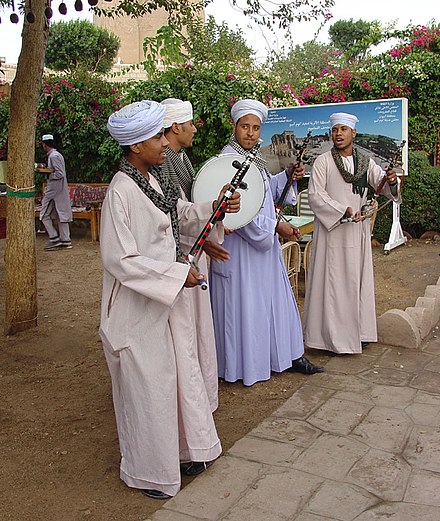
The jellabiya[citation needed], also jalabiya,[1] galabeya[2] or jalamia (Arabic: جلابية / ALA-LC: jilabīyah, Egyptian Arabic: galabiya, Egyptian Arabic: [ɡæ.læ.ˈbej.jæ, ɡæl.læ-]; "jelebeeya" in Ethiopia; "jehllubeeya" in Eritrea) is a loose-fitting, traditional garment from the Nile Valley. Today, it is associated with farmers living in Egypt (Greater Cairo, countryside, Luxor, and Aswan) and comes in rich color varieties. The garment is also worn in Sudan, but has other textures and is usually white,[3] as well as some communities from Eritrea and Ethiopia. The colorful Egyptian style is used by both men and women.[4]
The jellabiya differs from the Arabic thawb, as it has a wider cut, typically no collar (in some cases, no buttons) and longer, wider sleeves. Versions for farmers have very wide sleeves and sewn-in pockets used to carry tobacco, money, or other small items. Along the Red Sea coast in Egypt, and Sudan and among Beja tribesmen, the Arabic dishdash is preferred due to the jellabiya's relation to farming.
Jellabiya worn in summer are often white. During winter, thicker fabrics that are grey, dark green, olive, blue, tan or striped are used, and colorful scarves are worn around the neck. The garment is traditionally worn with an ammama (turban).
A full male dress in Sudan usually consists of three pieces, the jibba, the kaftan, and the sederi. The gebba/jibba, is the outermost garment characterized by a long opening over the chest. The urban version used to have this opening continue to the end, which made the jibba effectively a long coat. It has one pocket on one side and on the other side, just an opening that leads to a pocket in the Kaftan, the gallabiya's undergarment. The kaftan is perfectly aligned with the jibba and worn under it for protection against both heat and cold. It is also made of pure cotton to avoid irritation caused by the wool of the winter jibba. Between the kaftan and the jibba there is a sederi (vest) which has small pockets for money, cigarette packs, and even pistols. A traditional kamees and a sirwal are usually worn underneath the three piece suit.[citation needed]
Men's galabeya in Egypt typically have wider hems and sleeves in the country than in the city, and a wide neckline with a slit. In the city, there is usually a button placket instead of a simple slit.[5] Dull, solid colors, stripes, and plaid are considered appropriate for men's galabeya, while women's are usually prints and bright colors (or occasionally solid black).[6] In the summer, men's galabeya are made of cotton, while in winter they are made of flannel or wool in darker colors. A heavier galabeya may be worn on top of another and feature couched cord or braid decorations concentrated on the neckline, sometimes with braid buttons.[7]
In Egypt, two men's galabeya with collars exist: the galabeya frangi (foreign) which has a western shirt collar, and the galabeya scandarani (Alexandrian) which has a stand collar. They also have breast pockets and collars, buttoned placket front openings, high necklines, and a slightly tighter cut. These are seen as more sophisticated styles of men's galabeya compared to the standard.[8]
_Another_Egyptian_man_with_traditional_dress_named_jellabiya_(26321884786).jpg/440px-Egypt_(Luxor)_Another_Egyptian_man_with_traditional_dress_named_jellabiya_(26321884786).jpg)
,_Deir_el-Bahri,_near_Luxor,_Egypt_-_11_November_1961.tif/lossy-page1-440px-thumbnail.tif.jpg)
Women's galabeya are typically varied along regional lines. The two main styles are the galabeya bi wist (with waist) and galabeya bi suffra (yoked and loose). The former is common in Middle Upper Egypt from Beni Suef to Assiut, and the latter is common the Delta. Deep Upper Egypt has both, distributed along ethnic lines.[9]
The galabeya bi wist has a bodice and seoerate skirt. The skirt is either gathered or cut in a bell shape, with a length between the knee and the floor. The waist of the dress is higher than natural to accommodate pregnancy. Sleeves are always 3/4 length or longer, and may be gathered or narrow. The popular necklines are V neck, square, open, and collared, and may be combined in design. In Assuit the galabeya bi wist may have originated as a Coptic Christian fashion, but this distinction is no longer upheld.[9]
The galabeya bi suffra has long, full sleeves. The main differentiation is the decoration, shape of the yoke, presence of a collar, and style of closure.[9]
The women's galabeya in Boheria is distinguished by wide piping on the bust in a contrasting color. It is a galabeya bi suffra, and found further away from urban centers. The neckline is square, with rows of piping spaced apart from each other outlining it. The specifics of the rest of the piping employs a range of motifs. The dress is gathered, with three tucks in the center front to curtail the fullness from being unmanageable. The ruffle at the bottom of the dress is about 8 inches tall. The sleeves are full with three tucks along the length and two horizontal tucks at the shoulder, and ribbon and piping is used to outline the silhouette of a cuff. The dress fabric is always colorful.[10]